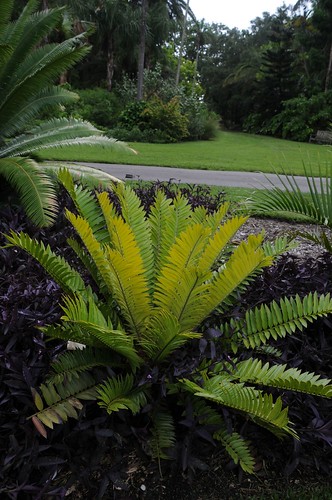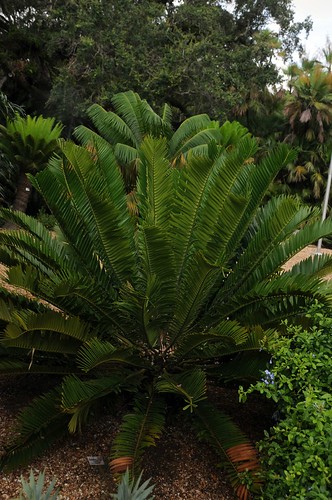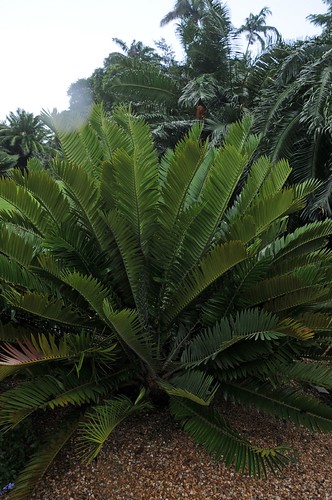This is the Natal cycad, Encephalartos natalensis. Its a large Enceph similar to E. altensteinii reaching around 6 metres in trunk. It is also a tremendously variable species with a number of clearly identifiable local forms. In fact there are enough variants to make a CD catalogue of its forms necessary.

E. natalensis is a widespread species and is common and popular in cultivation. Thousands of seedlings have been produced and there are also large colonies of wild plants on protected land in what is now known as KwaZululand, South Africa. It is arguable however that at least a few of the different forms should be split into separate species in which case some of these may prove to be endangered.
Which leads us on to the weird post title; E. natalensis has another claim to cycad fame. It seems to be the closest living relative of Encephalartos woodii which, as I have previously explained, is known only from a single male specimen and therefore is a) unable to reproduce sexually and b) a realistic contender for the title "rarest plant in the world".* In fact since they are so close, some have suggested the woodii plant is in fact a freakish outlier specimen of natalensis. Obviously a sample of one in this case makes genetic comparisons pointless. Another view put forward is that woodii originates as a wild hybrid between E. natalensis and E. ferox (of which more later). What everyone agrees on is that currently making seed of pure woodii is impossible and yet the cultivated woodii produce copious amounts of pollen so what to do? Well, a number of people have trod the obvious path and produced a plant like this:
This is an F1 Encephalartos natalensis X woodii and as such would typically be midway between the two in genetic terms. The plan would be to pollinate the f1 females with woodii pollen to create an F2 generation of Encephalartos "natalensis X woodii" x woodii and continue backcrossing until you end up with a generation of seedlings that are genetically almost indentical to E. woodii.
Of course such plants will never actually be woodii and the "rarity value" attaching to woodii remains. The value of "releasing" into the wild what we might term "genetically recreated woodiis" is questionable given the current plight of many other less commercially attractive Encephalartos regarding poaching. It is also I think ecologically questionable on additional grounds a) why not restore other similar species native to the region and b) what about the risk of genetically polluting those other similar species (including any hypothetical undiscovered wild female woodii). In fact I think the value of doing this at all from a restorative or scientific perspective is limited. However Encephalartos natalensis X woodii is an attractive plant with a great backstory which is ideal for horticultural marketing and can be used to take pressure off wild stocks of other species. In other words if anyone wants to give me one, I'd be more than happy to add it to my collection!
*It should be noted that Encephalartos relictus (the relict Encephalartos) is in the same position as E. woodii, ie extinct in the wild with all cultivated plants stemming from a single male individual. As it is less famous than woodii and less common in botanic gardens it is arguably rarer still than woodii
*It should be noted that Encephalartos relictus (the relict Encephalartos) is in the same position as E. woodii, ie extinct in the wild with all cultivated plants stemming from a single male individual. As it is less famous than woodii and less common in botanic gardens it is arguably rarer still than woodii



1 comment:
Stunning!! Wish I could grow these at home.
Post a Comment